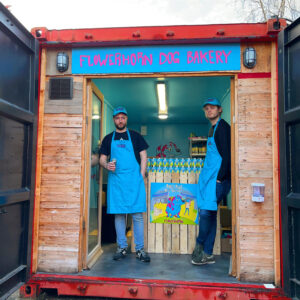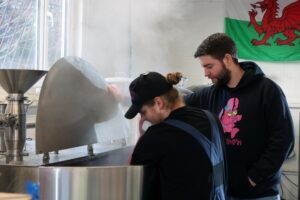An Interview with Flowerhorn Brewery
- Home
- /
- Uncategorized
- /
- An Interview with Flowerhorn Brewery
BLOG
An Interview with Flowerhorn Brewery
Meet Andrew Traynor. He’s the Co-Founder of Flowerhorn, a Cardiff based craft brewery and taproom. Launching in August 2019, Flowerhorn Brewery have been going from strength to strength over the last four years, specialising in modern, experimental beers with a focus on hoppy pale ales, fruity IPA’s, fruited sours and more recently a nitro stout.
Andrew has Congenital anosmia, the total inability to smell from birth. People born with this are often totally unaware until later in life when they begin to interact independently of their families. As part of Anosmia Awareness Day 2024, we wanted to spend some time with Andrew to learn a little more about the condition, whilst understanding about the challenges and support mechanisms available within the brewing industry.
C14CAE7E-E83
Can you start by telling us a little about Flowerhorn Brewery?
We brew all of our beers on-site and have 7,200 litres of fermentation capacity. Every weekend we clear out the brewery, put the tables out and convert into our taproom space. Our taproom is part of The Bridge Studios Shipping Container Yard in Cardiff which we share with many other small independent businesses. We have fresh beers pouring on our taps and street food is available from our neighbours Mr Croquewich. In the warmer months our yard acts as a large beer garden where we host markets, music and comedy events. We are also in the process of opening an off-site craft beer bar and street food venue with Mr Croquewich and are hoping to launch this in May 2024!
Supporting and collaborating with our local community is very important for us. In March 2023 we launched our side project, Flowerhorn Dog Bakery with the help of Food Innovation Centre Wales and a sustainability grant from the Welsh Government. We converted a shipping container into a kitchen and are using the waste product (spent grains) from the brewing process to create sustainable pale ale dog biscuits. Made from spent malt which is dehydrated, milled and mixed with flaxseed, flour and peanut butter, the result is a high protein, natural, vegan dog snack, which is packaged in eco-friendly pouches, aluminium tins and wrapped in compostable paper labels to keep it sustainable as possible. A portion of profits are donated to Cardiff based dog’s home, The Rescue Hotel.

How did Congenital anosmia affect you growing up, and what were some of the initial challenges that you faced?
I have no recollections of experiencing any sense of smell. Throughout my childhood, I frequently visited the doctors to seek answers, but unfortunately this didn’t lead to anywhere. Following one of the first visits, I was given a nose spray, which didn’t help. Returning to the doctors aged 20, they suggested that I have nose surgery for a deviated septum and there was a small chance that might help. This also didn’t make any difference.
Growing up I was quite embarrassed that I didn’t have a sense of smell and would often avoid contributing to conversations centred around smell. It’s very easy to be insecure and can be frustrating to not understand what others are experiencing.
Can you share a bit about your journey in the brewing industry and how anosmia may have impacted your work and passion for brewing beer?
I was never a fan of beer growing up. I had always found beers excessively bitter and couldn’t understand how they were so popular. When I was at university one of my friends gave me a can of his very mainstream, light lager and I started drinking beer. Part of the excitement of food and drink comes from trying products that are either unusual or that have a story. So, I began trying beers from across the world. Around this time my flatmates bought me a homebrew kit and I brewed my first batch of beer.
I studied Business Economics at Cardiff Metropolitan and instead of a dissertation I wrote a business plan for a world beer bar concept which I hoped to launch in Cardiff. After graduating this idea quickly evolved and from there, I decided I wanted to instead open a brewery. I knew I had a lot to learn and so I bought every book on brewery start-ups I could find, began homebrewing more seriously and found a job in a local brewery where I would get some crucial experience that developed into a passion for the industry. My friend Arran (now Co-Founder of Flowerhorn Brewery) was working with me and after many visits to breweries, beer festivals and pubs we began dreaming up what our ideal business would look like.
In my previous job I was working in sales and would travel across the UK visiting customers, visiting breweries, attending events and beer tastings. I would often be meeting with brewers, beer buyers and passionate consumers. This was always accompanied by trying different beers. Early on in my career I would avoid talking too much about the flavours of beer and often let others lead the conversation as I felt unqualified to do so. Nowadays I get more involved as I have a much better knowledge of ingredients and understand what beers are expected to taste like.

How has anosmia influenced your approach to brewing and recipe development? Are there any specific styles or ingredients that you find easier or perhaps more challenging to work with?
At the beginning I was heavily involved in recipe development. However, after moving into the current unit, Arran took on the role as Head Brewer and I now focus on Sales and Marketing as we felt this was a lot more appropriate.
Hops are one of the most exciting ingredients in beer and also one that is very difficult for anosmic people to experience. It can also be quite difficult to comprehend how hops flavour can be so diverse, ranging from wood, pine, tropical fruits, citrus fruits and even bubble gum.
I’ve never been a fan of bitter tasting food/drinks, and this translates to our own beers. All our beers have a low bitterness which keeps them very refreshing. We brew quite a lot of fruity IPA’s and sours which are generally sweeter and can be slightly tart. They are occasionally more reminiscent to juice than beer and I feel I get more out of the taste of these styles so naturally I am more drawn to them.
Have you developed any strategies or techniques to compensate for the loss of smell in your brewing process?
Co-Founder and Head Brewer Arran has overall responsibility for quality testing our beers. It’s usually not possible for me to detect off-flavours or taints and as I also struggle to sensorially profile hops, I recognise that this could affect our quality testing and consistency.
I find I pay more attention to the descriptions of beers, marketing them and sourcing of ingredients. I take a lot of pride in the quality of ingredients and use this as a big selling point.
When trying other beers, I have always been more focused more on their story than the actual taste as this contributes heavily to the overall experience for me and it’s something that translates to our own sales and marketing. Because of this I put a lot of effort into how our labels look, beer names and making sure we are using the best, most interesting hops available.
Is there any advice that you would give to others in the brewing industry who may be experiencing similar challenges with smell and taste disorders?
Don’t let it stop you! There are many roles in the brewing industry which aren’t reliant on a sense of smell or taste. Just surround yourself with people you trust and ideally find someone with a good palate.
Make sure you communicate this to your team so that everyone directly involved with your role fully understands the extent of your condition. It’s easy for people to forget that you have a smell or taste disorder, but if they understand they can step in to help when needed.
You have a unique taste perspective to others in the industry. You can focus on the five key basic human tastes as others can be distracted by the smells of the beer. Become a specialist on the sweetness, bitterness, astringency, acidity, water profiles, thickness, and carbonation levels in beer. Be confident and communicate your opinions to your colleagues as it can provide useful insights that can be used to develop and improve recipes.
Read up and listen to podcasts on beer styles, brewing methods and ingredients. This will give you the confidence and knowledge you need to be able to progress in the industry. Just because you can’t fully experience the flavours yourself, you can learn how to describe different beers based on the beer style and ingredients that were used.
Read spec sheets for malts, hops, and yeast from your suppliers as they can be very informative. They will tell you exact tasting notes that you can expect. Then get feedback from the industry and online resources when possible to see if the tasting notes are accurate in practice. You can also buy beers from breweries who have used specific ingredients and host a beer tasting with your team to get real time feedback and make a decision before experimenting with these ingredients yourself. The suppliers are experts in their ingredients and can be very helpful. If you feel comfortable to do so, explain your situation and they will talk you through the profiles of their products.
Are there any specific resources or support networks that have been particularly helpful to you in coping with anosmia, both personally and professionally?
Personally – I subscribed to the Fifth Sense newsletter about two years ago and have been reading their content ever since. It’s reassuring that there is a Charity organisation out there working on raising awareness for people affected by smell and taste disorders. I’m also lucky in that I get a lot of support from my friends, family, and girlfriend.
Professionally – I have read every brewery book I could find; I regularly watch YouTube videos on beer, and I listen to brewing podcasts as I am very passionate about the industry. I’ve learned a lot about malt, hops, yeast, and beer styles by doing this and it often gives me ideas for new beers.

In your opinion, what more can be done to support individuals in the brewery industry who are living with anosmia?
Breweries need to be equipped with fire alarms and air quality sensors which can alert everyone if there is a danger. If there is a CO2 leak in the brewery, someone with anosmia might be oblivious and if there is a fire, they will be slower to react which would create health risks.
On a performance level, people with anosmia should be given the chance to work in any department if there is a suitable team to support them. I was, and still am, heavily involved in recipe development, quality testing and ingredient selection despite having a limited perception on taste. It’s important to have someone you can trust to be completely honest and ideally with a good palette so you can work with them to develop the best possible beers.
Thank you for sharing your story and journey so far with Congenital anosmia, Andrew. Is there anything else that you would like to share with us?
We are looking to develop a beer focused on anosmia this year. The plan is to brew a beer that is centred around the five basic human tastes; sweet, salty, sour, bitter and umami. The idea is that this is a beer that can be fully enjoyed by anosmic and non-anosmic people alike and it will hopefully help to raise some awareness. We are specifically looking at a Gose beer, which is a traditional German-style sour wheat beer. It’s a style known for its slightly salty and sour taste – but we have some exciting plans to also use seaweed, fruit, sea salt and hops to flavour it! Keep an eye on our social media channels to watch this space!
Additional Resources & Links
If you would like to follow Flowerhorn on Instagram to keep an eye on what they are up to, then you can visit their page on; www.instagram.com/flowerhornbrewery
To find out more about the important work that Fifth Sense do, you can visit the Support and Resources section of their website; www.fifthsense.org.uk/support-resources/
To find out more about Anosmia Awareness, head over to; www.anosmiaawareness.org
NEWSLETTER SIGN UP
Receive the latest news, offers and sensory updates by signing up to our newsletter
